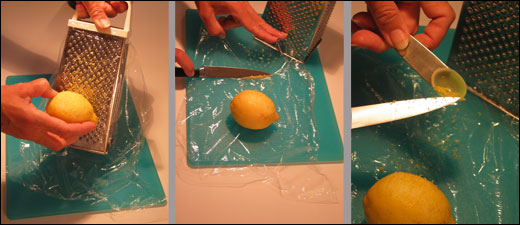Say yes to zest!
Lemons, limes, oranges, and other citrus fruits can add tons of flavor to a dish (without adding extra liquid) through their finely grated or slivered rinds, known as zest. The zest comes from the outer skin of the fruit, which is packed with aromatic oils. When using zest, always make sure to use only the colored portion of the skin—the white part (called the pith) is bitter and will ruin the flavor of the dish.
When a recipe calls for both zest and fruit or juice, remove the zest first, before cutting the fruit open. You'll find it easier and less messy to remove the zest from a whole piece of fruit than from one that's been cut open.

You can remove zest with special kitchen tools (called zesters or citrus strippers), but a plain box grater works especially well for making zest. To grate the zest and easily remove it from the grater, cover the finest grating surface with a length of plastic wrap, as shown in the following figure. The grating surface pokes through the plastic but the plastic itself doesn't grate into the zest. Rub the citrus across the plastic-covered surface (remember to grate just the colored part, not the bitter white pith). When you think you've grated enough (it takes a lot of grating to make a little bit of zest), lift off the plastic and scrape up the zest up with a flat edge, such as a dough scraper (shown in Chapter 3) or a knife. Use a measuring spoon to see if you've grated enough zest for the recipe.
Orange-Scented Couscous
This recipe uses zest.
Recipe © 1999 by Kate Heyhoe

Search this site:
Recipes
About These Recipes
Breakfasts, Brown-Bags & Breads
Brown-Bag Barcelona Chicken
Buttermilk Basil Dressing
Chinese "Barbecued" Pork
Cool-as-a-Cucumber Dressing
(A No-Flame, No-Fire Recipe)
Cranberry-Cinnamon
Poached Pears
Green Onion French Bread
Happy, Dappy, Flappy Jacks
Irma's Spiced Nuts-to-You
Mango-Cheese Quesadilla
Mexican Fiesta Taco
or Burrito Mix
Orange-Scented Couscous
Tips
Ten Items for Your
Kid's Cookware Kit
Kid-Friendlier Recipes
About Ingredients
Cooking with Fahrenheit
Eating wine and spirits
Cookie sheet & jelly roll pan
More Cooking Tips
General Cooking Tips
Food at Hand: Eating
Finger Foods
Alexandria's Top Ten Cooking
Tips for Other Kids
Ten Kids-in-the-Kitchen
Commandments


